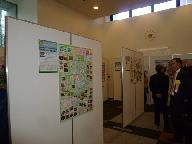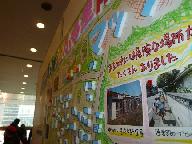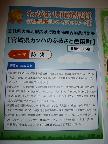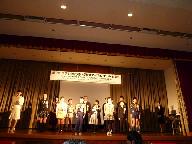Japan is
the most natural disaster prone country in the world. About ten percent of all
earthquakes of the entire world occur in this small country which occupies less
than one percent of the world’s total land area. There also consistently occur floods
and eruptions of volcanos.
Having suffered from natural disasters
repeatedly over time, Japan has developed various types of education for
disaster preparedness. The Child Explorers’ Disaster Prevention Map Contest is
one such educational project, which started as a way to make use of the lessons
learned from the Great Hanshin Awaji Earthquake in 1995. Making a map of your community
is learning about the area. If children assume this role, they will provide
fresh perspectives to adults, and it can stimulate discussions with their
parents about how to prevent disasters in their community.
The
following article reports on the awarding ceremony of the 9th Disaster
Prevention Map Contest, which was held on January 29, 2013.

Nippon
Volunteer Network Active in Disaster (NVNAD) has been promoting the Annual Elementary
School Children Explorers’ Disaster Prevention Map Contest in cooperation with the
General Insurance Association of Japan and the Asahi Shimbun (Newspaper) Company.
It was our pleasure to co-host the 9th contest this year. I attended
the awarding ceremony held in Tokyo today. This year, more than 2,000 maps were
submitted by more than 400 groups nationwide. A total of 13,000 children joined
the activity and probably more than 100,000 adults supported them. I am pleased
that so many people have become involved in this project, and would like to
express my gratitude to those who have facilitated the growth of this project.
Today, special prizes were given to the seven
teams selected from 15 award winners that had passed the first, second, and
final round of selection. The seven special prizes were: Minister of Education,
Culture, Sports, Science and Technology Award, Minister of State for Disaster
Management Award, Commissioner of the Fire and Disaster Management Agency Award,
Community’s Disaster Management Kids Award (Director of the Japanese National
Commission for UNESCO Award), Community Design Award for the Future (the Asahi
Shimbun Company Award), Disaster Prevention Explorers Award (General Insurance
Association Award), and Rediscover My Town Award presented by NVNAD.

At the
final selection round last month, NVNAD’s staff decided to present their award
to the “Disaster Prevention Map of the Hometown of Kappa (a mythical river spirit) made by a team of 16 fifth graders in
Miyagi Prefecture (Team Shikama Town, the Hometown of Kappa, from Kami Fire Department, Oosaki Broader-based Local
Government Clerical Work Union), which is within the disaster affected area of
the Great East Japan Earthquake and Tsunami. This map, which featured the
mythical kappa legend passed down in
the area, reflected the members’ attachment to their community. On the map,
they also presented the top five of both the troublesome things and the useful
things in case of disaster based upon their experiences in the Great East Japan
Earthquake and Tsunami. To make the map easy to read, they represented buildings
on the map in three dimensions using Styrofoam. One of the boys and an adult
instructor attended the award ceremony representing the group. They looked nervous
as they received the certificate and prize. All the award winners were interviewed
on the stage after receiving the awards. Then we all listened to the comments
of Professor Murosaki of Kwansei Gakuin University who served as the Chief Judge.

Professor
Murosaki praised everyone’s efforts saying that each of the maps display the
thoughtfulness of the children as well as those of the adults who warmly watch over
them in the community. He pointed out that the children are to play the leading
role in responding to the next serious disaster, and underlined the importance
of them developing the knowledge about their community and deepening their attachment
to it through making such maps. After sharing some tips for map-making, he
reminded us of the children who could not join this contest because their
circumstances did not allow them to make maps. He was referring to the fact
that the applications from the coastal areas in Iwate, Miyagi, and Fukushima
Prefectures had remarkably decreased. He extended empathy for the children who
had lost their “home towns,” and concluded his speech with the remark that perhaps
when we receive applications from children in those areas again, it will be a
sign that reconstruction is happening.
This project was originally started by NVNAD as the Workshop on
Rediscovering our Town after the 1995 Great Hanshin-Awaji Earthquake. At the
beginning, it was a small activity only in Nishinomiya City, which had
experienced the earthquake. Then the General Insurance Association in Japan
took a keen interest in it, and it was developed to a nationwide scale in
cooperation with the Asahi Shimbun Company. It is a very unique and meaningful
project in the way it places children at the core while increasing the
awareness about disaster prevention among adults. It boosts disaster management
of each community without simply repeating the overused words of “disaster
prevention.” NVNAD considers it to be one of our most significant activities,
calling it “disaster prevention without saying disaster prevention.” I am
impressed to see this project has grown to involve so many people nationwide. I
would like to thank again the organizations including the General Insurance
Association in Japan and the Asahi Shimbun Company for sponsoring awards.

It
was touching to see the children receive the awards with a serious expression
while showing their delight from head to foot. The proud look on the faces of
their instructors and parents were also moving. NVNAD continues to work with
the people who promote disaster prevention in their communities. I would like
to congratulate the winners again. At the same time, we also recognize that all
the other maps which were submitted to the contest are also the fruits of the
participants’ hard work in the communities. In fact, no community map is
superior to the others. Let’s continue to make efforts to protect our
communities from disasters! Thank you very much.
Originally
reported in Japanese on 29 January, 2013